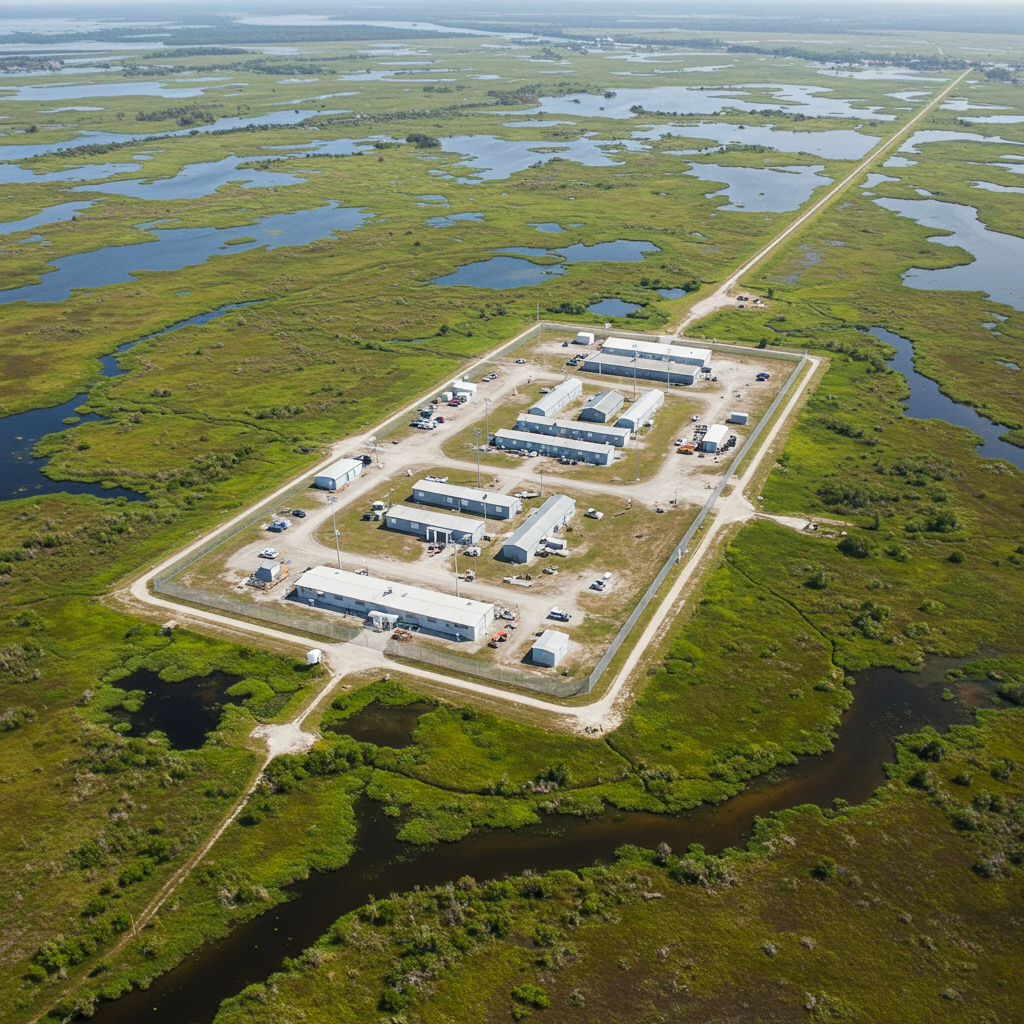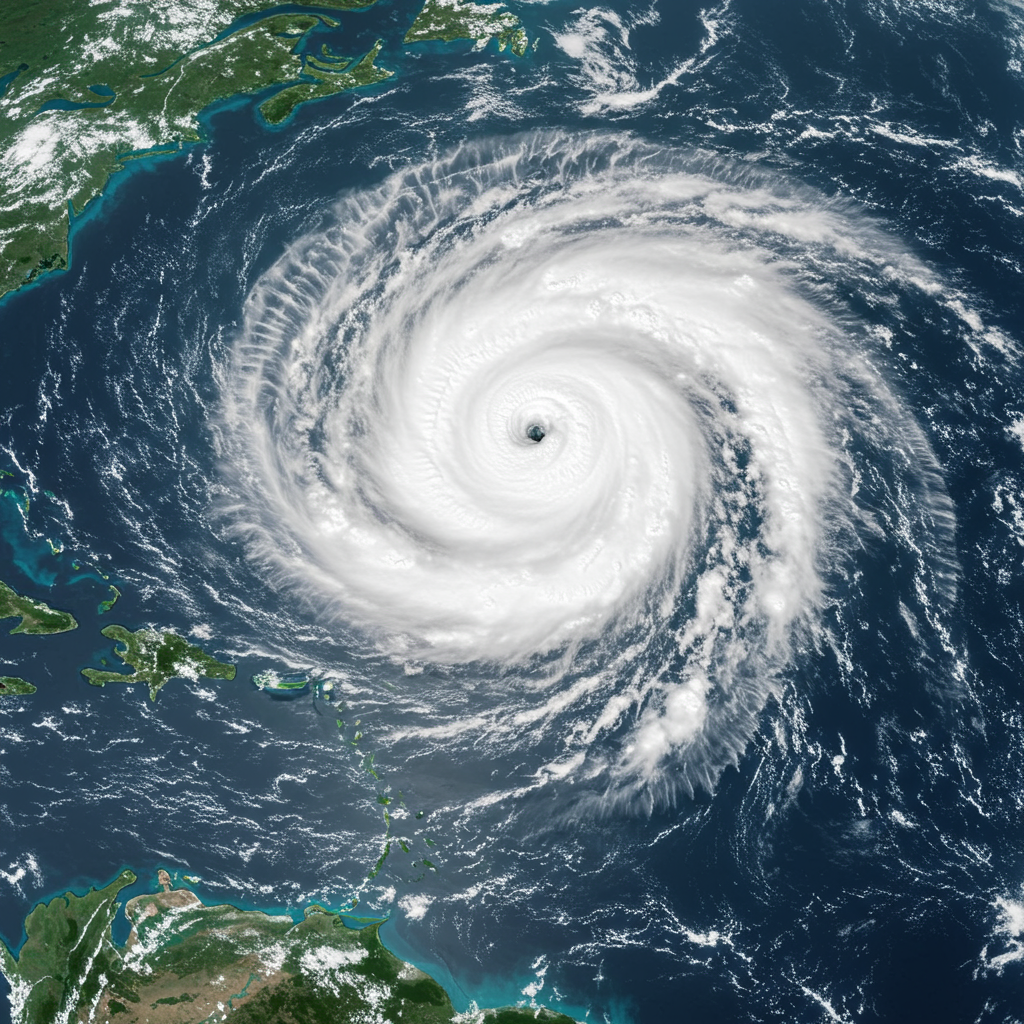Deep within the vast, marshy landscape of the Florida Everglades, a new and highly contentious site has rapidly emerged: a temporary migrant detention facility. Controversially nicknamed “Alligator Alcatraz,” this encampment sits less than 50 miles west of Miami, transforming a little-used airstrip into a focal point for the intense debate surrounding immigration enforcement in the United States.
In a matter of days, the Dade-Collier Training and Transition Airport, originally built as a massive jetport before environmental concerns halted its full development, was converted. Workers quickly erected a temporary tent city on the site’s 11,000-foot runway and surrounding areas. This rapid transformation signals a significant push by state and federal officials to increase detention capacity as part of intensified deportation efforts.
Building the Everglades Encampment
The facility, officially designated as a temporary holding site, was swiftly assembled following a request from the federal government. Florida Governor Ron DeSantis openly embraced the “Alligator Alcatraz” moniker, originally coined by his attorney general, James Uthmeier. Officials estimate the site will initially house up to 5,000 migrants awaiting processing or deportation, with plans potentially expanding capacity to 10,000 beds.
The camp is described as being “completely self-contained.” Migrants will be housed in structures resembling FEMA trailers and soft-sided temporary facilities, similar to those used for natural disaster relief. These structures are intended to provide shelter from the harsh Florida climate, including high heat, humidity, and potentially severe storms during hurricane season. State officials have indicated that evacuation plans are being developed in case of severe weather threats.
Security is a key feature emphasized by proponents. The facility is equipped with over 200 security cameras and more than 28,000 feet of barbed wire perimeter. Over 400 security personnel are expected to staff the site, operating round-the-clock. Officials also tout the location itself as a natural barrier. Surrounded by treacherous wetlands teeming with alligators and other dangerous wildlife, the remote site is presented as inherently difficult to escape from.
The High Cost and Rapid Deployment
While state Republicans have promoted the project as a “low cost” solution, the facility comes with a substantial price tag. Estimates suggest the annual operating cost could reach $450 million. Although Florida is initially fronting these costs, state officials plan to seek significant reimbursement from the federal government, largely through FEMA’s shelter and services program.
Governor DeSantis utilized his emergency powers to expedite construction, bypassing some standard processes. This move came despite skepticism from Miami-Dade County, which owns the airport site and had raised concerns about the proposal, including its environmental implications and the acquisition price offered by the state, which was far below the property’s appraised value. The site’s conversion into a detention center marks a dramatic shift for the Dade-Collier airport, which has primarily served as a training facility for years.
Officials justify the facility’s necessity by citing the need to alleviate burdens on state and local law enforcement agencies and jails. These facilities have reportedly seen an influx of individuals apprehended amid increased federal immigration enforcement activities. Governor DeSantis described the facility as a “force multiplier” aimed at boosting the rate of removals and deportations. There are also plans to utilize the large runway for direct deportation flights from the site.
Controversy Erupts Over Location and Conditions
The “Alligator Alcatraz” project has sparked intense backlash from a broad coalition of critics. Immigration rights activists, environmentalists, and members of the state’s Indigenous communities have voiced strong opposition, calling the facility inhumane and a threat to sensitive ecosystems and sacred lands.
Immigration advocates argue the facility is “engineered to enact suffering.” They draw parallels to controversial past detention sites, such as Sheriff Joe Arpaio’s tent city in Arizona. Critics worry about the welfare of thousands of people detained in temporary tents in the sweltering Everglades heat during hurricane season. Terms like “dehumanizing” and “a theatricalization of cruelty” have been used to describe the project’s location and nature. Concerns have also been raised about the lack of oversight in a remote, rapidly constructed facility.
Adding to the criticism is the language used by some officials. Florida Attorney General James Uthmeier notably stated that if people escaped, “there’s not much waiting for them other than alligators and pythons.” White House Press Secretary Karoline Leavitt echoed this, stating that the wildlife served as a “deterrent” to escape attempts. Opponents contend that treating people as if they are “vermin” by highlighting natural dangers is cruel and reflects a dehumanizing approach to immigration enforcement.
Environmental and Cultural Impacts Feared
Environmental groups are highly skeptical of officials’ claims that the facility will have “zero impact” on the surrounding Everglades. They highlight the site’s proximity to a crucial source of freshwater for South Florida and an ecosystem home to endangered species. Conservationists worry about the potential effects of housing and processing thousands of people, including issues related to waste management, water usage, lighting, generators, and general human activity in a fragile wetland environment.
Several environmental organizations, including Friends of the Everglades and the Center for Biological Diversity, have filed a lawsuit seeking to halt the project. They allege that state and federal officials bypassed federally required environmental reviews and public comment periods. The historical context of the site reinforces these concerns; plans for a massive international jetport there were stopped in 1970 precisely because a federal report concluded it would “inexorably destroy the South Florida ecosystem.”
Members of the state’s Indigenous communities, particularly the Miccosukee and Seminole Tribes, also oppose the facility. They view the land where the airport and detention center are being built as sacred ancestral territory. Betty Osceola, a Miccosukee Tribe member and environmental activist, expressed shock and outrage that a detention facility would be placed on land her people consider home and come to for prayer. Tribal members are concerned about the impact on their cultural heritage and the potential threat to the delicate ecosystem that is integral to their way of life and supplies drinking water for millions. They feel officials dismissed their connection to the land by stating “Nobody lives out here.”
Political Messaging and Deterrence
The development and promotion of “Alligator Alcatraz” are intertwined with broader political messaging. The facility is presented by the Trump administration as a key component of its goal to ramp up deportations and increase national detention bed capacity significantly. During a visit to the site, President Trump praised the facility and suggested it could serve as a model for other states. He also made light of the dangers posed by the local wildlife, joking about escaping from alligators.
Governor DeSantis similarly emphasized the facility’s effectiveness as a “cost-effective and innovative way” to expand capacity and accelerate removals. The explicit mention of the site’s natural hazards by officials, including AG Uthmeier’s video featuring red-eyed alligators and a DHS image depicting alligators wearing ICE hats, underscores a deliberate strategy. This approach aims to convey a harsh message globally that violating U.S. immigration laws will result in severe consequences, including detention in difficult conditions in isolated locations. The Florida Republican Party has even utilized the facility for fundraising efforts, selling themed merchandise.
However, critics view this emphasis on harsh conditions and natural dangers as a “callous political stunt” and an attempt to use the location to inflict “physical and psychological torture.” They challenge the narrative that the facility is solely for those with criminal records, pointing to data showing a significant number of detainees held by ICE have no criminal history. The focus on deterrence through harshness also comes amid concerns about rising deaths in ICE custody nationwide.
Frequently Asked Questions
What is the “Alligator Alcatraz” facility and where is it located?
“Alligator Alcatraz” is the controversial nickname for a new, temporary migrant detention facility built by the state of Florida in the Everglades. It’s located at the Dade-Collier Training and Transition Airport, approximately 50 miles west of Miami. The site is situated within the remote wetlands of the Big Cypress National Preserve, near Everglades National Park, an area known for its challenging terrain and dangerous wildlife, including alligators.
Who is opposing the facility and what are their main concerns?
Opposition comes from several groups: immigration rights advocates concerned about the welfare of detainees in temporary structures exposed to harsh climate and potential oversight issues; environmental groups worried about the impact on the fragile Everglades ecosystem and alleging a lack of required environmental reviews; and Indigenous communities (Miccosukee and Seminole Tribes) who view the site as sacred ancestral land and fear cultural and environmental damage. Critics also view the facility as a politically motivated and inhumane project.
What are the environmental and cultural concerns surrounding the site?
Environmental concerns focus on the potential impact on the Everglades’ delicate ecosystem and vital freshwater supply from housing thousands of people and associated infrastructure like waste management and generators. The site was previously part of a failed jetport project halted due to environmental risks. Culturally, Indigenous tribes consider the area sacred ancestral homeland adjacent to their villages, viewing the facility’s construction as an affront to their heritage and connection to the land.
Conclusion
The rapid construction of “Alligator Alcatraz” in the Florida Everglades highlights the intense and often harsh realities of current immigration enforcement policies. While state and federal officials frame the temporary facility as a necessary and effective tool for increasing detention capacity and deterring illegal immigration, particularly by leveraging the site’s remote and naturally hazardous environment, the project faces significant opposition. Humanitarian concerns over the welfare of detainees, environmental worries about the impact on a vital ecosystem, and cultural objections from Indigenous communities underscore the deep divisions surrounding the facility. As lawsuits proceed and protests continue, the future of this controversial Everglades encampment remains a subject of ongoing debate and scrutiny.



